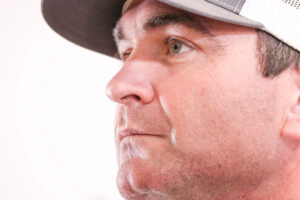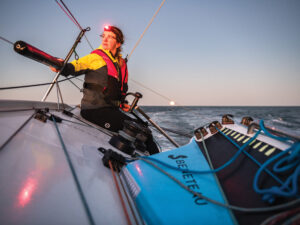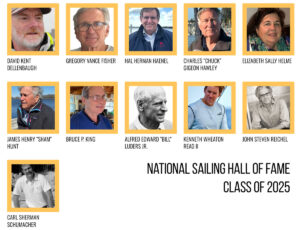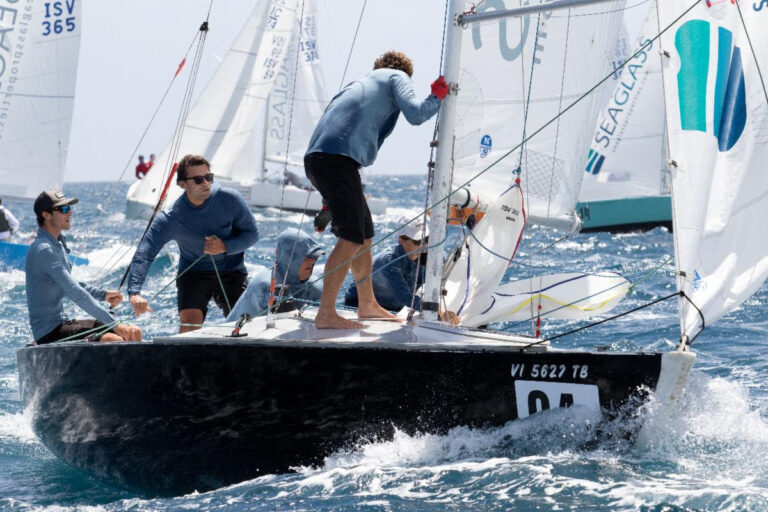
the wind had been light through the first 110 miles of Storm Trysail Club’s annual springtime Block Island Race, and as we were making our way back toward the finish, we found ourselves navigating through and against an annoying ebbing tidal current in The Race. This 3-mile-wide deep channel at the entrance to Long Island Sound is notorious for its swift and turbulent currents. It’s where this race and many others have been won and lost.
As we worked our way through The Race, there was a pesky TP52 keeping pace to the south of us. At this point, we should have been at least 5 miles ahead of them, but I was happy to have them nearby because tactical scrimmages keep crews focused and racing at peak performance. Their presence had us hyperalert and searching for any and all advantages. The wind was patchy, with random puffs alternately accelerating our boat and then the TP52. The seesaw battle continued for hours until an opportunity appeared out of nowhere.
We were sailing with a light asymmetric spinnaker, jibing with each favorable puff and windshift while the conversation among the afterguard addressed the critical conundrum of this race: Do we favor the Long Island shoreline or the Connecticut? While we remained open to either option, a tidal rip appeared off the bow. To help understand whether there was some kind of current sheer on one side of the agitated water, we had the aid of a GPS system that calculated whether there was a favorable or unfavorable current. After we crossed the tidal rip, our boat suddenly gained 1.4 knots of speed over the bottom. By taking bearings on the nearby TP52, it was clear that we were making dramatic gains.
After sailing for a short period in this advantage, we passed through another set of tidal rips, and we were immediately slowed by an adverse 0.5-knot current. It was obvious right then and there that we needed to stay within the narrow band of favorable current, so we jibed frequently to stay in phase with the current. And as we did so, our rivals on the TP52 appeared to be stopped dead while we gained bearing. It’s amazing how crew morale improves when sailing faster than a competitor.
Tidal currents are influenced by the gravitational forces of the moon. Gravity also plays a role as water flows from higher elevations to lower levels. The prevailing direction and strength of the wind also has a strong influence on currents. On a large body of water such as Long Island Sound, tidal flow can be predicted with accuracy thanks to lunar cycles, but the actual water flow, especially at the surface, can change with every new tide and every weather system. Eddies flowing in the opposite direction can suddenly appear and then disappear, and currents from adjacent rivers and streams feeding into the sound add to the dynamics of tidal flow. It would be fascinating to hover over The Race and Long Island Sound for a long period of time to watch the changes in currents. Every day and every hour would be different.
While enjoying this miraculous magic-carpet ride toward the finish, I thought back to the many times I had suffered through calms and fought against capricious foul currents while watching competitors sail away.
For racing sailors, finding the least adverse current or the most favorable downstream current can make a substantial difference in performance. During the downwind leg of the race, for example, we lost considerable apparent-wind strength as we moved along with the current. This meant sailing a higher course than normal to maintain our velocity made good. We also lost distance by making frequent jibes. I estimated that each maneuver cost about one boatlength, but the higher course and extra jibes were small sacrifices compared with the boost in speed from the favorable current.
Through binoculars I could see someone on the TP52 staring intently at our boat as we maneuvered through the tidal rips. They too were taking bearings and trying to figure out what to do. These narrow bands of current change unpredictably, so we didn’t know how long our good fortune would last.
While enjoying this miraculous magic-carpet ride toward the finish, I thought back to the many times I had suffered through calms and fought against capricious foul currents while watching competitors sail away. It’s not a good feeling, and I had compassion for the TP52 crew. We were lucky to be in a good geographical spot on that particular morning, but it could have been the other way around.
The good times continued for 14 miles down the racecourse as we enjoyed 90 minutes of favorable current that helped us extend our lead by 3 miles. In the end, it wasn’t enough to beat the TP52 on corrected time, but it gave our crew a psychological boost, improved our position to third place in the 37-boat ORC fleet, and served as a poignant reminder to never underestimate the effects of tides and currents.
Before any coastal distance race, a deep study of the movements of the water is a must. There are published guides and locals with great intel, as well as navigational tools and software that can give you a strong foundation. Most important, however, is to be hypervigilant to the water’s movements at all times, constantly looking for clues on the surface such as current ribbons, trap buoys, birds and fish, and the fishermen who congregate at tidal rips.
A recent Opera House Cup, raced off Nantucket, will forever be a good reminder to me to be on the lookout for a tidal advantage. This annual regatta for classic yachts is a favorite among the sailors who put great effort into preparing their boats for this unique contest. The race committee is mindful that many of the boats in the fleet are antiques and therefore set courses with four legs so that most of the race is spent reaching around the course. For this particular edition of the Opera House Cup, I was invited to skipper an International 30-Square Metre, which is a long narrow Scandinavian craft, with its number designating its sail area.
Our class featured 18 boats, and we started on a beam reach in a strong 16-knot breeze. We won the start and looked good, but within a few minutes, it was clear that our boat was off the pace. By the time we rounded the first turning mark, we were well behind our entire class. The next 10-mile leg sent the fleet along a shoreline that ran for at least 8 miles. I noticed a tidal rip right along the shore, so with nothing to lose, I bore off to sail into the choppy water, and we slid into a countercurrent that was running along at 1.5 knots.
Meanwhile, all of the other boats were fighting a 1-knot current. From our position at the back of the fleet, we quickly started to gain bearing. By the time we reached the next turning mark after 90 minutes of racing, we were well out in front. We held on to our lead over the final two legs to finish first in class and third in the entire fleet. It was a happy sail back to Nantucket Harbor.
I could fill this space with tales of races that did not end as well as these two triumphs, but the lessons for all of us are to keep our eyes open and always look for opportunities. Currents are an especially important element of every race strategy, so take the time to study where you typically race, but remember that the flow will never be the same. That’s the beauty of our sport—like tidal currents, the unpredictability is what keeps it interesting.









